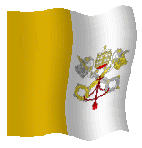Tuesday, December 25, 2007
Urbi et Orbi, Christmas 2007
Sunday, December 23, 2007
Restoration for Belfast's oldest (original) Catholic church
The church, distinctive with its unique castle-like turrets, its fan-vaulted ceiling and unorthodox shape, has suffered the ravages of time and war. In 1941, two Luftwaffe bombs fell nearby, blowing out all the windows. The Irish oak window frames were replaced as an emergency measure with concrete which is now decaying. However, experts have told parish priest Fr Anthony Curran that the replacement frames did more damage than the German bombs.St Malachy's famous turrets are also in a sad state and 23,000 of the building's hand-made bricks will need to be replaced as part of the £3.5m renovation. The church will close in early January for between 12 and 15 months.
The building was one of those affected by the changes recommended in the 1960s by the Second Vatican Council which favoured a somewhat minimalist approach to the interior of Catholic churches. As a result, many churches suffered what some clergy now call "ecclesiastical vandalism" with the loss of splendid features such as high altars, altar railings and mosaic flooring.
St Malachy's curate, Fr Martin Graham, said marble steps leading to the altar would replace the wooden version installed 40 years ago and the altar rails and mosaic tiles would be restored. "A new marble altar will be installed, the gift of a parishioner," Fr Graham said. "The panelling around the Sanctuary will be stencilled in many colours, returning it to its original look. Two new side altars, to Saint Francis and Saint Anthony, will be installed and the other side altars will be renovated. "The seating in the church will also be remodelled and the paintings above the altar will be cleaned and restored."
Although St Malachy's was built in the traditional cruciform shape, it is unorthodox in that the building is broader than it is long. Fr Graham said the original plans were for a church of cathedral size which would seat 7,000 people and cover much of present day Clarence Street opposite. With potato crops failing and many people living in grinding poverty, church leaders of the day took the decision, Fr Graham said, to "spend the money on food for the poor, rather than on bricks". The plans were subsequently altered leading to the truncated appearance which adds to the charm of the building.
St Malachy's priests have launched a restoration fund to help cover the expense of the renovation with parishioners and visitors invited to "pay for a brick" or dedicate one of the new seats to a loved one. Fr Graham said: "It is not just a great building, it is a living and working church serving its parish and thousands of the people who come to this part of Belfast for work and shopping. "In the bustle of the city, the church offers them a place of peace for quiet prayer and reflection. The time ahead is challenging but Saint Malachy's Church has stood for 166 years because many generations have cared for it. "Now it's this generation's turn to hand it on those who will come after us."
Christus natus est
Saturday, December 22, 2007
Blair Converts
The BBC has the story HERE.
Sunday, December 16, 2007
Do some work!
Really, have these people nothing better to do?
It reminds me of the alleged response of Blessed John XXIII to the question 'How many people work in the Vatican?'
His answer...
'About half!'
Sunday, December 09, 2007
Why does Rocco Palmo write for The Tablet?
Time for the winter woolies again!
Monday, December 03, 2007
Where in the World...?
Poland - Wrzesnia, Poznan
United States - Eugene, Oregon
United Kingdom - Edinburgh, Edinburgh, City of
United Kingdom - London, London, City of
Croatia - Metkovic, Dubrovacko-Neretvanska
Ireland - Cavan
United States - Fort Worth, Texas
United States - Trenton, Michigan
United States - Bridgewater, Massachusetts
United Kingdom - Alyth, Perth and Kinross
United Kingdom - Derby
Croatia - Zagreb, Grad Zagreb
United Kingdom - Belfast
Switzerland - Herzogenbuchsee, Aargau
Poland - Lwowek Slaski, Jelenia Gora
Belgium - Brussels, Brussels Hoofdstedelijk Gewest
Germany - Rthenbach, Bayern
United Kingdom - Grays, Thurrock
Germany - Essen, Nordrhein-Westfalen
New Zealand - North Shore
United States - Coupeville, Washington
United States - Freeport, New York
United States - Los Angeles, California
United States - Brooklyn, New York
United States - Jersey City, New Jersey
Ireland - Kilkenny
Welcome to one and all!



